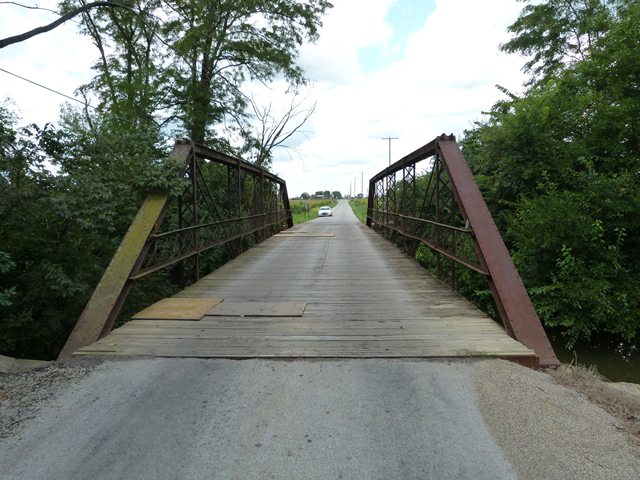We Recommend:
Bach Steel - Experts at historic truss bridge restoration.
Newcomer Road Bridge

Primary Photographer(s): Nathan Holth
Bridge Documented: August 12, 2012
Rural: Morrow County, Ohio: United States
By Builder/Contractor: Wrought Iron Bridge Company of Canton, Ohio
2000
80.0 Feet (24.4 Meters)
81.0 Feet (24.7 Meters)
13.5 Feet (4.11 Meters)
1 Main Span(s)
5930146

View Information About HSR Ratings
Bridge Documentation
View Archived National Bridge Inventory Report - Has Additional Details and Evaluation
With an 80 foot span, this is a long span example of a pony truss with pinned connections. The bridge is also significant as an example of a pony truss bridge built by the Wrought Iron Bridge Company. The bridge comes with the unusual and noteworthy details that this company often included in their pony truss bridges. These details include threaded rod with nut connections for the diagonal members to the top of the end post. This connection point also includes a cast iron connection assembly. The bridge also uses threaded rod with nut for the bottom chord connection to the end post. Again, a cast iron detail is found here, which functions both as a bearing/shoe piece and a connection assembly. These details are all intact on the bridge and unaltered.
This bridge is thus historically and technologically significant for its unusual builder-associated details and its span length. The National Bridge Inventory gives an 1874 construction date for this bridge. No plaque remains on the bridge itself, and the Historic Bridge Inventory comments that the source of the date is unknown. Without proof of the date's validity, HistoricBridges.org is always dubious anytime a Wrought Iron Bridge Company pony truss has an 1874 construction date reported, and similarly, an 1876 construction date reported if the bridge is a Wrought Iron Bridge Company through truss. The Wrought Iron Bridge Company, like many bridge companies, typically included a builder plaque on its bridges. However, Wrought Iron Bridge Company was unusual (and somewhat annoying) in that it often did not include the date of construction on its plaques, a detail nearly always included on the plaques of other bridge companies. Instead, Wrought Iron Bridge Company listed the fact that the bridge was patented and they then listed the patent date. For their pony truss bridges, the relevant patent date was 1874, and for their through truss bridges, the patent date was 1876. Because of this, Wrought Iron Bridge Company bridges are frequently misreported in the National Bridge Inventory and other sources as having been built in those years, when in reality they were built several years after the patent was issued. For this reason, HistoricBridges.org is listed the construction date for this bridge as unknown. It likely dates to ca. 1880.
Information and Findings From Ohio's Historic Bridge InventorySetting/Context The bridge carries a 1 lane of a rural road over a stream in a rural area of active farms. The road narrows at the bridge. Posted for 6 tons. Physical Description The 1 span, 81'-long, wrought-iron, pin-connected, Pratt pony truss bridge has built-up compression members and eyebar tension members. Those at the end panels are connected with upturned ends through cast iron connecting pieces, a detail common to early WIBC metal truss bridges. The verticals are built up using the bulb T section that is also a hallmark of the company and was intended to make a stiffer member. One abutment is concrete and one is ashlar. The floorbeams are in kind replacements, otherwise the bridge appears to be complete. The floorbeams appear to be original to the bridge. The waterway has migrated. Integrity Rehabilitated in 2000 but remarkably complete. Has not been painted in many years. There is impact damage to the upstream truss. Summary of Significance The 1874 pony truss is a very early and very technologically significant example of its type/design by a prominent Ohio fabricator. It appears to be the oldest Pratt truss highway bridge remaining in Ohio. The
2000 rehabilitation did not adversely impact the overall integrity of original design. The eligible recommendation of the prior inventory remains appropriate. The source of the date is unknown (2009). Justification The bridge is the oldest example of its design in the state, and it is remarkably complete. It has early details that are particular to the WIBC. Bridge Considered Historic By Survey: Yes |
![]()
Photo Galleries and Videos: Newcomer Road Bridge
Bridge Photo-Documentation
Original / Full Size PhotosA collection of overview and detail photos. This gallery offers photos in the highest available resolution and file size in a touch-friendly popup viewer.
Alternatively, Browse Without Using Viewer
![]()
Bridge Photo-Documentation
Mobile Optimized PhotosA collection of overview and detail photos. This gallery features data-friendly, fast-loading photos in a touch-friendly popup viewer.
Alternatively, Browse Without Using Viewer
![]()
Maps and Links: Newcomer Road Bridge
Coordinates (Latitude, Longitude):
Search For Additional Bridge Listings:
Bridgehunter.com: View listed bridges within 0.5 miles (0.8 kilometers) of this bridge.
Bridgehunter.com: View listed bridges within 10 miles (16 kilometers) of this bridge.
Additional Maps:
Google Streetview (If Available)
GeoHack (Additional Links and Coordinates)
Apple Maps (Via DuckDuckGo Search)
Apple Maps (Apple devices only)
Android: Open Location In Your Map or GPS App
Flickr Gallery (Find Nearby Photos)
Wikimedia Commons (Find Nearby Photos)
Directions Via Sygic For Android
Directions Via Sygic For iOS and Android Dolphin Browser
USGS National Map (United States Only)
Historical USGS Topo Maps (United States Only)
Historic Aerials (United States Only)
CalTopo Maps (United States Only)

